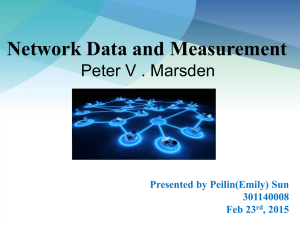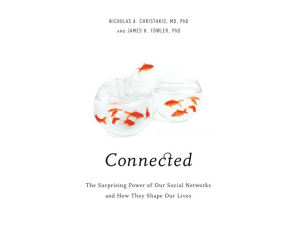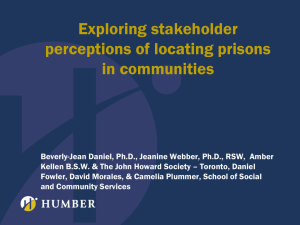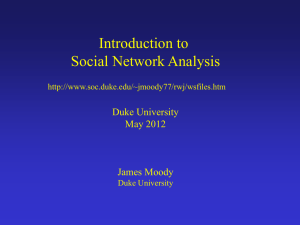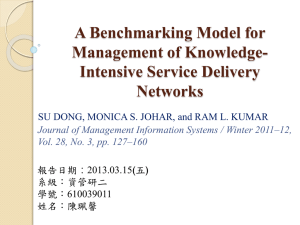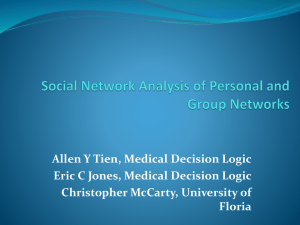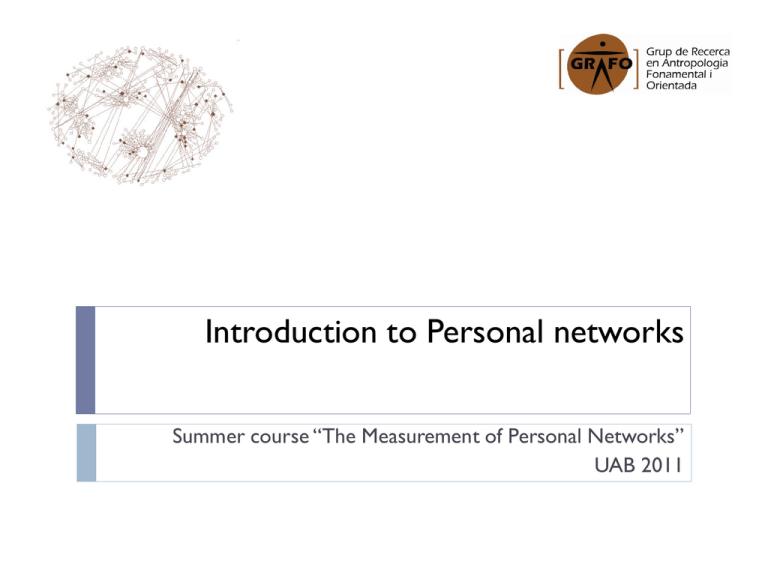
Introduction to Personal networks
Summer course “The Measurement of Personal Networks”
UAB 2011
The plan for this week
Introduction to personal network analysis
Name generators
Name interpreters
Reliability and validity of network data
Mixed methods designs
Workshops with software for collecting, visualizing and analyzing
personal network data:
EgoNet (José Luis Molina)
E-Net (Steve Borgatti)
Vennmaker (Markus Gamper)
(not specifically for personal networks) visone (Jürgen Lerner)
The plan for this morning
Introduction to personal networks.
1.
•
•
•
•
2.
3.
A bit of history
Distinction between sociocentric, egocentric and
personal networks
A definition of personal networks.
An overview of research in the area.
Types of personal network data
Designing a personal network study (goals, design,
and sampling).
1. Introduction to Personal
Networks.
History and difference with sociocentric
networks
A bit of History …
The “Manchester School”, led first by Max Gluckman
and later by Clyde Mitchell, explored the personal
networks of tribal people in the new cities of the
Cooperbelt (but also in the India, Malta, Norway)
Faced with culture change, mobility and
multiculturalism they used social networks as an
alternative to Structural-Functionalist Theory in
anthropology
Radcliffe Brown
–
–
A. R. Radcliffe Brown, a structural-functionalist, became
disillusioned with the concept of culture and anthropological
approaches using an institutional framework
As an alternative he suggested focusing on social relations,
which, unlike culture, could be observed and measured directly
•
“But direct observation does reveal to us that these human beings are
connected by a complex network of social relations. I use the term
“social structure” to denote this network of actually existing
relations.” (A.R. Radcliffe-Brown, "On Social Structure," Journal of the
Royal Anthropological Institute: 70 (1940): 1-12.)
Two branches in the development of social network
analysis
Sociology
Anthropology
Moreno
Radcliffe-Brown, Nadel
Coleman, H. White, Harary,
Freeman, Rogers, Davis,
Lorraine
Gluckman, Mitchell, Bott,
Barnes, Kapferer, Epstein,
Boissevain, Warner, Chappel
Granovetter, Burt, Wellman,
Snijders, Frank, Doreian,
Richards, Valente, Laumann,
Kadushin, Bonacich, …
Romney, Bernard, Wolfe,
Johnson, Schweizer, D. White
INSNA
For a complete review of the history of SNA read: Freeman, L. C. (2004). The Development of
Social Network Analysis: A Study in the Sociology of Science. Empirical Press.
For instance …
Red externa o
extendidad
Mónica
Gossip network …
(Epstein, 1957)
Mrs.
Mutwale
Nicholas
=
Besa
Phiri
Ponde
Misma tribu o grupo lingüístico
Dirección del chisme
Misma escuela
Vecinos
Misma iglesia
East York …
(Wellman, 1984,
1999)
Vecinos
Inmediata
Familia
Extendida
Persona
de East
York
Lazos íntimos
activos
Lazos no íntimos
activos
Amigos
Compañeros de trabajo
Two kinds of social network analysis
Personal (Egocentric) Network
Analysis
Whole (Complete or
Sociocentric) Network Analysis
Effects of social context on
individual attitudes, behaviors …
Interaction within a socially or
geographically bounded group
Collect data from respondent (ego)
about interactions with network
members (alters) in all social
settings.
Collect data from group members
about their ties to other group
members in a selected social
setting.
Not a Simple Dichotomy
The world is one large (un-measurable) whole network
Personal and whole networks are part of a spectrum of
social observations
Different objectives require different network “lenses”
Personal Networks: Unbounded Social Phenomena
Example: Predict depression
among seniors using the
cohesiveness of their personal
network
Social or geographic space
• Social influence crosses social domains
• Network variables are treated as attributes of respondents
• These are used to predict outcomes (or as outcomes)
Whole networks: Bounded Social Phenomena
Focus on social
position within
the space
Social or geographic space
Example: Predict depression among seniors using social position in a Retirement Home
Overlapping personal networks: Bounded and Unbounded
Social Phenomena
Use overlapping networks as a
proxy for whole network
structure, and identify
mutually shared peripheral
alters
Social or geographic space
Example: Predict depression among seniors
based on social position within a Retirement
Home and contacts with alters outside the
home
A note on the term “Egocentric”
Egocentric means “focused on Ego”.
You can do an egocentric analysis within a whole
network
See much of Ron Burt’s work on structural holes
See the Ego Networks option in UCInet
Personal networks are egocentric networks within
the whole network of the World (but not within a
typical whole network).
Summary so far
When to use whole networks
When to use personal networks
If the phenomenon of interest occurs within a socially or
geographically bounded space.
If the members of the population are not independent and tend to
interact.
If the phenomena of interest affects people irrespective of a
particular bounded space.
If the members of the population are independent of one another.
When to use both
When the members of the population are not independent and
tend to interact, but influences from outside the space may also be
important.
Definition of personal networks
Personal network
The set of social relationships surrounding an individual, which
stem from different contexts (family, work, neighbourhood,
associations, religious community, school, online community…).
“Ego”: the focal individual
“Alter”: a network member
Personal network
The set of social relationships surrounding an individual, which
stem from different contexts (family, work, neighbourhood,
associations, religious community, school, online community…).
“Ego”: an informant
“Alter”: a network member
Personal network
The set of social relationships surrounding an individual, which
stem from different contexts (family, work, neighbourhood,
associations, religious community, school, online community…).
“Ego”: an informant
“Alter”: a network member
Personal network
The set of social relationships surrounding an individual, which
stem from different contexts.
“Ego”: an informant
“Alter”: a network member
Boundary specification
± 1500
± 500
Personal network ± 150
Active or close network ± 50
Sympathy group ± 15
Support clique ± 5
Robin Dunbar:
Hierarchically
inclusive levels of
acquaintanceship
ego
“Dunbar’s number”
http://www.cabdyn.ox.ac.uk/complexity_PDFs/CABDyN%20Seminars%202007_2008/
CABDyN%20Seminar%20Slides%20RIMDunbar.pdf
How many people does a person know?
Year-long observation of two individuals (Boissevain, 1973):
Contact diaries: Pool & Kochen´s (1978) 1 person experiment:
Gurevitch (1961) 18 persons:
Fu (2007): 54 persons, 3 months:
Telephone Book Studies (Freeman & Thompson, 1989): Estimate based on
the number of names informants recognize from a random sample of surnames
from a telephone book, extrapolated to match the total number of names in the
phonebook.
± 1750
500-1500
2130
227
5520
Reversed Small World experiment (e.g., Killworth & Bernard, 1978/79):
Informants are asked who is the most appropriate first intermediary to send a
package to each of 1267 (originally) or 500 persons in the world, each equipped
with a location and an occupation. Extrapolation based on distribution.
Known population method (Bernard et al., 1991): Estimate based on the size
of the population, the size of 20-30 known subpopulations, and the number of
persons one knows in each of the subpopulations. Various studies.
250
2025
±290
611
►
Summation method (McCarty et al., 2001): Sum of respondents’ estimates of
the number of people they know in each of 16 relationship categories
Extrapolation on the basis of the relation between neocortex size and
average group size of primates (Dunbar, 1993)
Christmas cards (Hill & Dunbar, 2003)
±290
150
125
How many people does a person know?
►
Year-long observation of two individuals (Boissevain, 1973):
Contact diaries: Pool & Kochen´s (1978) 1 person experiment:
Gurevitch (1961) 18 persons:
Fu (2007): 54 persons, 3 months:
Telephone Book Studies (Freeman & Thompson, 1989): Estimate based on
the number of names informants recognize from a random sample of surnames
from a telephone book, extrapolated to match the total number of names in the
phonebook.
Revised by Killworth et al. at
Reversed Small World experiment (e.g., Killworth & Bernard, 1978/79):
Informants are asked who is the most appropriate first intermediary to send a
package to each of 1267 (originally) or 500 persons in the world, each equipped
with a location and an occupation. Extrapolation based on distribution.
Known population method (Bernard et al., 1991): Estimate based on the size
of the population, the size of 20-30 known subpopulations, and the number of
persons one knows in each of the subpopulations. Various studies.
Revised by McCormick et al. (2010) at
Summation method (McCarty et al., 2001): Sum of respondents’ estimates of
the number of people they know in each of 16 relationship categories
Extrapolation on the basis of the relation between neocortex size and
average group size of primates (Dunbar, 1993)
Christmas cards (Hill & Dunbar, 2003)
± 1750
500-1500
2130
227
5520
2025
250
±290
611
±290
150
125
Distribution of c in the population
(McCormick, doctoral thesis, 2011)
Back to the definition
The set of social relationships surrounding an individual, which
stem from different contexts.
“Ego”: the focal individual
“Alter”: a network member
Definition affects the network characteristics, e.g.
Core ties
Relatively few
Kin-centered (± 50% *, **, ***)
High homogeneity
Multistranded
Low spatial dispersion
Peripheral ties
More numerous
Low proportion of kin (± 20% #)
Low homogeneity
Specialized
Spatially more dispersed
(67% at max 1 hr **)
High density
(.57 for 3 ties*; .44 for 18.5 ties**,
but see .33 for 5 ties***)
Relatively stable over time
* Marsden, 1987
** Fischer, 1982
*** Wellman, 1979
(40% #)
Lower density
(± .25 for 41,5 peripheral ties #)
Unstable over time
#These
are very rough estimates based on proportions
reported by McCarty (1992) for networks of 60 ties, taking
into account values for 18.5 core ties based on Fischer
This is only the strength of ties, but…
Personal networks tend to display high clustering,
particularly in relation to roles / settings of meeting
Contents, frequency of relationships, …
An overview of research
An overview of research into personal networks
Interest in patterns and processes of socialization and social
integration
Predicting interindividual variation in these patterns
The influence of personal networks on individual outcomes
Network-based interventions
Use of personal networks as a means for other goals - studying hard-toreach populations
Method development
predictors
networks
outcomes
(1) Description of patterns and processes of
socialization and social integration
The personal network represents the social context of an
individual, the intermediate level between the individual and
society, an essential mechanism by means of which the individual
is connected to the larger world
Shows the current pattern of sociability, although it is in part a
product of the past
Personal networks are used to understand the organization of
informal relationships in society at large
Examples
What effects does the far-reaching social systemic division of labor
have on the organization and content of primary relationships?
(“The Community Question”, Wellman, 1979)
Are Americans more socially isolated now than they were twenty
years ago?
(McPherson, Smith-Lovin, Brashears)
What are the processes of socialization and social integration as
young persons enter adulthood?
(Bidart et al.)
To what extent do immigrants and natives mix in society?
(Molina, McCarty, Lubbers / Molina, Lozares, Lubbers)
Is online sociability differently structured than offline sociability? Is it
replacing offline sociability?
(Wellman and associates)
Is it a small world (local clustering and short path lengths)?
(Milgram, Watts & Strogatz)
Personal networks are unique
Like snowflakes, no two
personal networks are
exactly alike (courtesy to
José Luis )
Social networks may share
attributes, but the
combinations of attributes
are different
Example of the variation of personal networks (45 alters)
2. Explaining variations in personal networks
Do the size, composition, structure, stability of networks
vary with individual characteristics?
At the relationship level, do alter characteristics affect the
contents of the relationship with ego, the stability of the
relationship, or the existence of the ties with other alters?
Demographic characteristics, education, personality, life events, …
E.g., Louch (2002)
Comparison across societies
E.g., Fischer-Fischer/Shavit-Grossetti-Bastani; Burt-Ruan-Völker
(3) The influence of personal networks on individual
and social outcomes
Influences on: mental and physical health, job mobility,
migration decisions, risky behavior, geographical
mobility…
Four areas of research into the influence of personal
networks:
A. Social support
B. Social capital
C. Diffusion and contagion
D. Network geographies
(3a) Social support
Barrera,Vaux, Berkman, Uchino… / Fischer, Antonucci…
Three elements (Vaux, 1988; Barrera, 1986):
Personal networks are sources of social support
Sources of social support (social integration)
Types of social support received (enacted social support)
Appraisal of social support (perceived social support)
Instrumental, emotional, informational support, social companionship
Theories of social support and mental and physical health:
Social support helps individuals to cope with major life
stressors and the challenges of daily life, thereby protecting
them from the negative consequences of stress on health
Social support maintains well-being in the absence of stress.
Social support becomes part of an adaptive personality profile
throughout a person’s life.
Social support studies
e.g., Ertel, Glymour & Berkman, 2009
Host of studies showing direct and/or buffering effects of
social support on mental and physical health
Explanatory pathways, e.g., for cardiovascular diseases:
Perceived social support has direct relations with
cardiovascular reactivity to stressors, neuroendocrine and
immune systems
Strong and supportive alters promote health behaviors (sleep,
diet, exercise,…)
Provision of informational and tangible resources
…
The strength of weak ties / structural holes…
Granovetter / Burt
Research focused mainly on the beneficial effects of
strong ties
Granovetter (1973) showed that weak ties can be
instrumentally strong too …
The search for a job (Granovetter, 1974)
The search for a place to live (Freeman & Sunshine, 1976)
The search for an abortionist (Lee, 1969)
Burt (1992): It is not the quality of any particular tie but
rather the way different parts of networks are bridged
(“structural holes”)
Network structure and its effects
Illustration: Sune Lehmann, Complexity and Social Networks Blog: http://www.iq.harvard.edu/blog/netgov/
(3b) Social capital
Bourdieu, Coleman, Wellman, Lin, Burt, Marsden, Flap…
People have human capital (abilities), economic capital
(material resources) and social capital
Social capital refers to the resources embedded in
one’s network which are accessed and/or mobilized
through one’s ties in purposive actions
Returns can be instrumental (wealth, power, reputation)
or expressive (health and life satisfaction)
Focus on embedded resources (e.g., wealth and power
of alters) and network locations (e.g., structural holes).
Social capital exists at the individual level and at the
community level
Social capital and job prestige (Lin, 1999)
A host of studies show that access and mobilization of
embedded resources significantly enhances the attainment
of jobs with higher prestige of the job, controlling for
education, father´s status, etc.
They also showed that:
The strength of tie is negatively related with contact status
Father´s status is positively related with contact status
(3c) Diffusion and contagion
Valente, Coleman, Costenbader, …
Social networks are the infrastructures for social influence.
Diffusion: Ideas and practices spread through networks. As
friends do something, you are more likely to do something.
Contagion is the special case of diffusion in which only contact
is required for adoption/spread.
Both sociocentric and egocentric network data are used for
studying such models
Applied to innovations (Coleman,Valente), diseases and
health conditions (e.g., Klovdahl, the Christakis & Fowler
studies), mobilization to protest (Opp & Gern, 1993; Araya
Dujisin, 2009), …
Diffusion
Structural models:
Structural aspects of the network influence adoption (size of
the network, weak ties, brokerage…)
Threshold models (Valente):
Individuals engage in a new behavior based on their network
exposure (the number of others in the network who already
engage in that behavior)
Individuals have different thresholds for adoption
Example: Framingham Heart Study
Christakis & Fowler
Christakis “the illness of the person dying affects the health
status of other individuals in the family (…) a kind of nonbiological transmission of disease”
http://www.edge.org/3rd_culture/christakis08/christakis08_index.html
Does obesity, happiness, smoking cessation, alcohol
consumption, loneliness,… spread through personal
relationships?
FHS:
Longitudinal study over 30 years (measurements each 5 years)
among residents in the town Framingham, Massachusetts
Respondents were asked to identify their spouse, relatives, “close
friends,” place of residence (neighbours), and place of work
(coworkers)
As alters were often also participants in the Framingham Heart
Study, personal networks could be combined to study the
community
Evolution of obesity in the Framingham Heart Study
Christakis & Fowler, 2007
Christakis & Fowler (2007), New England Journal of Medicine, 357, 370-379
(3d) Activity spaces
The spatial dispersion and structure of personal networks
can be regarded as indicators of individual “activity
spaces” that influence individual mobility patterns (e.g.,
Axhausen et al.; also Carrasco et al.)
The illustration is from: http://www.civ.utoronto.ca/sect/traeng/ilute/processus2005/PaperSession/
Paper18_Axhausen_ActivitySpacesBiographies_CD_.pdf.
(4) Hidden and hard-to-count populations
Design of network-based sampling methods
Snowball sampling:
A small number of initial participants is selected (“seeds”) from
the target population
Who provide researchers with information on their network
connections, who subsequently form the pool from which new
participants are selected
Who are asked — and typically provided financial incentive—to
recruit their contacts in the population directly
Current sample members (inform about their networks to)
recruit the next wave of sample members, and so on,
continuing until the desired sample size is reached.
Figure by Thomas Valente
(4) Hidden / hard-to-reach populations
Respondent driven sampling (Heckathorn, 1997, 2002, 2007)
combines network-based (snowball) sampling with a
mathematical model of the recruitment process that
weights the sample to compensate for non-random
recruitment patterns
RDS generates approximately unbiased population
estimates, but the variance of RDS estimates are higher
than in random samples
(4) Hidden / hard-to-reach populations
Some key issues and assumptions in respondent-driven sampling
Seeds should be selected carefully and should comprise key subpopulations
Respondents know one another as members of the target population, and
respondents know sufficient others (3-5) to keep the recruitment process going.
Respondents are linked by a network composed of a single component, or if they
are not, seeds represent the different components.
Sampling occurs with replacement.
Respondents can accurately report on the number of personal contacts they
have within the target population – to be used to adjust for selection bias.
Peer recruitment is a random selection from the recruiter’s network.
Each respondent recruits a fixed and small number of peers (e.g., 3).
Researchers should keep track of whom recruited whom – to be used to
generate relative inclusion probabilities
Long recruitment chains (sometimes up to 20) allow for deeper penetration
into the target population networks and help to ensure that the sample meets
several theoretical assumptions indicating representativeness
Networks with 1st and 2nd degree alters
Graphs by Thomas Valente
(4) Size of hidden populations
(Killworth et al., 1998; McCormick, Salganik & Zheng, 2010)
Design of network-based methods (scale-up methods) to
estimate the size of hidden, hard-to-count populations (e.g., at risk
for HIV)
It assumes that everyone’s network in a society reflects the
distribution of subpopulations in that society
So, if you know:
(a) the size of the total population within which the subpopulation is
embedded;
(b) the number of people whom informants know in a subpopulation;
(c) the total number of people whom informants know (the personal
network size)
you can estimate:
(d) the size of the subpopulation (= a × b / c)
Development of methods to estimate the personal network size.
The known population method
The summation method
(5) Method development
Methods for measuring aspects of personal networks and
for collecting personal network data
Software development such as Egonet, E-net, Vennmaker, …
Paper-and-pencil methods (e.g., Hogan et al., 2007)
Estimates for social capital and network size
Methods for the statistical analysis of personal network
data, e.g.,
Triad counts (Kalish & Robins, 2006)
Duo-centered studies (Coromina et al., 2008)
Joint analysis of dynamics in network structure and network
composition (Lubbers et al, in preparation)
An overview of research into personal networks
Interest in patterns and processes of socialization and social
integration
Predicting interindividual variation in these patterns
The influence of personal networks on individual outcomes
Network-based interventions
Use of personal networks as a means for other goals - studying hard-toreach populations
Method development
Summary
For the measurement of personal networks, it is
important to operationally define what constitutes a
social relationship, based on the research question
In the case of influence, it is important to specify the
mechanism through which personal networks are
expected to influence individual outcomes
Usually based on some form of transmission from node to
node (resources, information, affection, ideas, control, sanctions,
disease…).
Define under which conditions these transmissions take
place (structural and relational constraints and opportunities)
Aggregation of these transmissions
Types of personal network data
Personal network data
We collect data on relationships…
The relationships that an informant has with others
The relationships that the others have among them
…in order to aggregate them to variables that
characterize the networks
Number of the informant’s relationships –
Contents of the informant’s relationships –
Existence of relationships among the others –
Size
Composition
Structure
Personal network data
Some questions are analyzed at the relationship level, e.g. ,
Are kin relationships more supportive than acquired relationships?
Do stronger ties persist better over time?
Others at the network level, e.g.,
Do people with larger support networks cope better with [some sort
of life event] than people with smaller support networks?
Are geographically dispersed networks less dense?
Types of aggregate personal network data
Composition: Variables that summarize the attributes of alters
and of ego-alter relationships in a network.
Structure: Metrics that summarize the structure of alter-alter
relationships, e.g.
Average age of alters.
Proportion of alters who are women.
Proportion of alters who provide emotional support.
Density.
Number of components.
Betweenness centralization.
Composition and Structure: Variables that capture both.
Sobriety of most between alters.
E-I index.
Ego-alter relationships and network composition
Alter summary file
Name
Closeness
Relation
Sex
Age
Race
Where Live
Year_Met
Joydip_K
5
14
1
25
1
1
1994
Shikha_K
4
12
0
34
1
1
2001
Candice_A
5
2
0
24
3
2
1990
Brian_N
2
3
1
23
3
2
2001
Barbara_A
3
3
0
42
3
1
1991
Matthew_A
2
3
1
20
3
2
1991
Kavita_G
2
3
0
22
1
3
1991
Ketki_G
3
3
0
54
1
1
1991
Kiran_G
1
3
1
23
1
1
1991
Kristin_K
4
2
0
24
3
1
1986
Keith_K
2
3
1
26
3
1
1995
Gail_C
4
3
0
33
3
1
1992
Allison_C
3
3
0
19
3
1
1992
Vicki_K
1
3
0
34
3
1
2002
Neha_G
4
2
0
24
1
2
1990
.
.
.
.
.
.
.
.
.
.
.
.
.
.
.
.
.
.
.
.
.
.
.
.
Personal network composition variables
Characteristics of alters
and ego-alter relationships
Aggregate variables of
network composition, e.g.:
•
Sex
•
Proportion of women
•
Age
•
Average age of network alters
•
Occupation
•
Range of occupations (Highest
– lowest score)
•
Strength of tie
•
Proportion of strong ties
•
Duration of tie
•
Average duration of ties
•
Place of residence of alter
•
Geographical dispersion
Percent of alters from host country
36 Percent Host Country
44 Percent Host Country
• Percent from host country captures composition
• Does not capture structure
Alter-alter relationships and network structure
Alter adjacency matrix
Joydip_K
Shikha_K
Candice_A
Brian_N
Barbara_A
Matthew_A
Kavita_G
Ketki_G
.
.
.
Joydip_K
1
1
1
1
0
0
0
0
.
.
.
Shikha_K
1
1
0
0
0
0
0
0
.
.
.
Candice_A
1
0
1
1
1
1
1
1
.
.
.
Brian_N
1
0
1
1
1
1
1
1
.
.
.
Barbara_A
0
0
1
1
1
1
0
0
.
.
.
Matthew_A
0
0
1
1
1
1
1
1
.
.
.
Kavita_G
0
0
1
1
0
1
1
1
.
.
.
Ketki_G
0
0
1
1
0
1
1
1
.
.
.
.
.
.
.
.
.
.
.
.
.
.
.
.
.
.
.
.
.
.
.
.
.
.
.
.
.
.
.
.
.
.
.
.
.
.
.
Personal network structure variables
Alter positions
in structure
Aggregate variables of
network structure:
Degree centrality
Average degree centrality
(density)
Closeness centrality
Average closeness centrality
Betweenness centrality
Average betweenness
centrality
Core/periphery
Number of components
Number of isolates
Components
Components: 1
Components: 10
• Components captures separately maintained groups (network structure)
• It does not capture type of groups (network composition)
Average Betweenness Centrality
Average Betweenness 12.7
Average Betweenness 14.6
SD 26.5
SD 40.5
• Betweenness centrality captures bridging between groups
• It does not capture the types of groups that are bridged
Designing a personal network study
Goals, design, sampling
Make sure you need a network study!
Personal network data are time-consuming and
difficult to collect with high respondent burden
Sometime network concepts can be represented with
proxy questions
Example: “Do most of your friends smoke?”
By doing a network study you assume that the
detailed data will explain some unique portion of
variance not accounted for by proxies…
It is difficult for proxy questions to capture structural
properties of networks
Sometimes the way we think and talk about who
we know does not accurately reflect the social
context
Neighbors
Close friends
Former job
diverse acquaintances
My family and me
distant family
Hairdresser
Friends & acquaintances
from the workplace
friends
people from the workplace
acquaintances from the
workplace
Family in
Serbia
Friends
here from
Bosnia
Neighbors
Friends
Husband
family
FAMILY
WORK
FRIENDS
Research methods to capture personal networks
Observation (Boissevain)…
Surveys
Contact diaries (Fu, Lonkila, …)
Experiments (Killworth & Bernard)
Extraction of data from SNS (Boyd, Hogan, …) / mobile
phones (Lonkila)
Steps to a personal network survey
Part of any survey
1. Identify a population.
2. Select a survey mode.
3. Select a sample of respondents.
4. Ask questions about respondent.
Unique to personal network survey
4. Elicit a list of network members (“name generator”).
5. Ask questions about each network member.
6. Ask respondent to evaluate alter-alter ties.
7. Discover with the informant new insights about her personal
network (through visualization + qualitative interview).
1. Selecting a Population
Choose wisely, define properly – this largely will determine
your modes of data collection and the sampling frame you will
use to select respondents.
Certain populations tend to cluster spatially, or have lists
available, while others do not
Race and ethnicity may seem like good clustering parameters,
but are increasingly difficult to define.
2. Modes of Survey Research
Face-to-face, telephone, mail, and Web (listed here in order
of decreasing cost)
The majority of costs (minus incentives) are not incurred
in actually interviewing the respondent, but in finding
available and willing respondents
Depending on the population, there may be no
convenient or practical sample frame for making
telephone, mail, or email contact
3. Sample Frames
This can be thought of as a list representing, as closely as
possible, all of the people in the population you wish to study.
The combination of population definition and survey mode
suggests the sample frames available.
Sample frames may be census tracts, lists of addresses,
membership rosters, or individuals who respond to an
advertisement.
Prevalence vs. Relations
Estimate the prevalence of a personal network
characteristic in a population
Sampling should be as random and representative as possible.
Sample size should be selected to achieve an acceptable margin of
error.
Example: Sample 400 personal networks to estimate the
proportion of supportive alters with a five percent margin of error.
Analyze the relation between a personal network
characteristic and some outcome variable
Sampling should maximize the range of values across variables to
achieve statistical power.
Example: Sample 200 personal networks of depressed and 200 of
not depressed seniors to test whether the number of isolates is
associated with depression.
4. Questions about Ego
These are the dependent (outcome) variables you will
predict using network data, or the independent (explanatory)
variables you will use to explain network data and for
controls
Outcome variables: Depression, Smoking, Income, …
Explanatory variables: Number of moves in lifetime, Hobbies, …
Controls: Age, Sex, …
Be aware that it is common to find relationships between
personal network variables and outcomes that disappear
when control variables are introduced
Steps to a personal network survey
Part of any survey
1. Identify a population.
2. Select a survey mode.
3. Select a sample of respondents.
4. Ask questions about respondent.
Unique to personal network survey
4. Elicit a list of network members (“name generator”).
5. Ask questions about each network member.
6. Ask respondent to evaluate alter-alter ties.
7. Discover with the informant new insights about her personal
network (through visualization + qualitative interview).
Steps to a personal network survey
Part of any survey
1. Identify a population.
2. Select a survey mode.
3. Select a sample of respondents.
4. Ask questions about respondent.
Unique to personal network survey
4. Elicit a list of network members (“name generator”). TOMORROW
5. Ask questions about each network member.
6. Ask respondent to evaluate alter-alter ties.
7. Discover with the informant new insights about her personal
network (through visualization + qualitative interview).
Steps to a personal network survey
Part of any survey
1. Identify a population.
2. Select a survey mode.
3. Select a sample of respondents.
4. Ask questions about respondent.
Unique to personal network survey
4. Elicit a list of network members (“name generator”).
5. Ask questions about each network member.
6. Ask respondent to evaluate alter-alter ties.
7. Discover with the informant new insights about her personal
network (through visualization + qualitative interview).
WEDNESDAY

